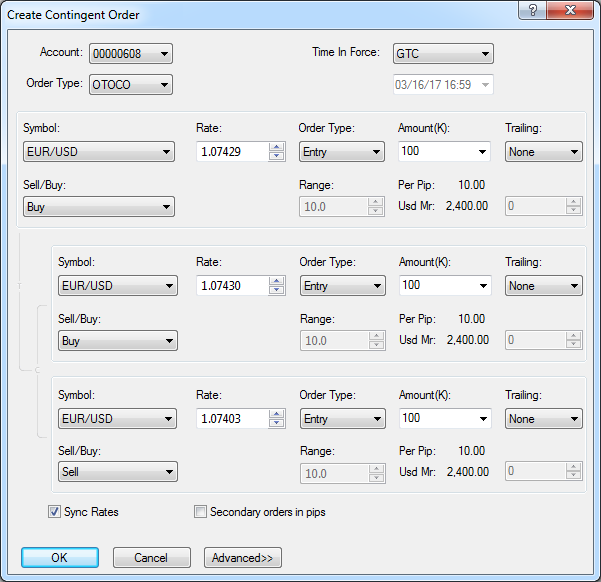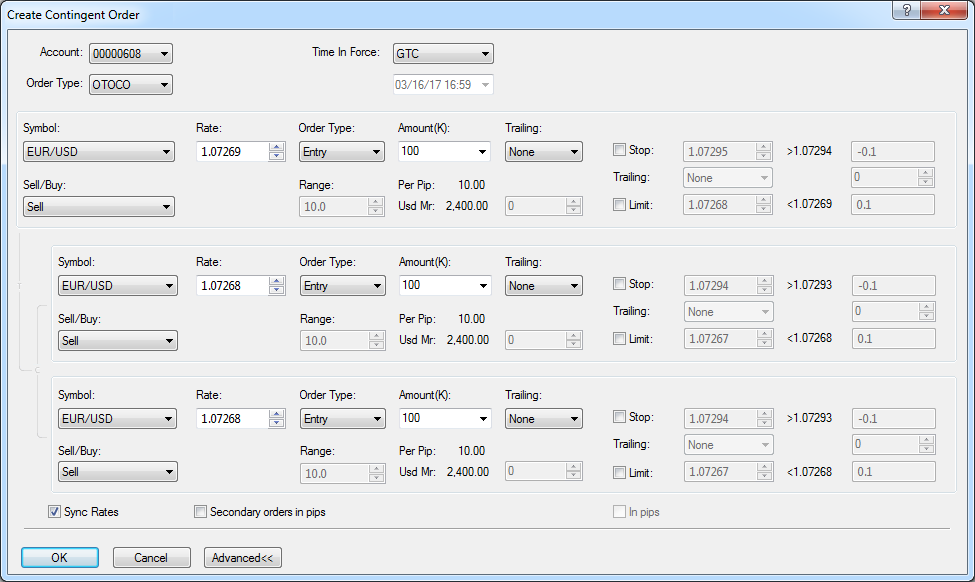- In the Dealing Rates window, right-click in the field of a symbol of your choice, and then click Create Contingent Order.
- In the Entry Orders list of the Orders window, right-click an entry order of your choice, and then click Create Contingent Order.
- On the Trading menu, point to Dealing Rates or Orders, and then, in the menu that appears, click Create Contingent Order.
- Press ALT+E
If the value of the Order Type box is OTOCO, leave it as it is, otherwise, click the arrow
 , and then click OTOCO.
, and then click OTOCO.
- In the Account box, click an account of your choice if you have more than one account.
- In the Time In Force box, click an option of your choice. If you click GTD (Good Till Date), in the date box below, select or type the order's expiration time. By default, it is the time when the current trading day ends.
- In the Symbol boxes, click a symbol of your choice for all orders.
- In the appropriate Rate boxes, select or type price values of your choice for all orders.
- In the Order Type boxes, select an order type for all orders. If you select Range Entry, select or type values of your choice in the appropriate Range boxes.
- In the appropriate Amount (K) boxes, select or type amount values of your choice for all orders.
The cost of one pip price movement and amount of the used margin of the specified amounts appear in the Per Pip and Usd Mr boxes respectively.
Note: Depending on the version of your trading station, instead of Amount (K) you can see Currency/Point in this dialog box. You can specify the Amount mode option at your choice in the Options dialog box of your trading station. For details, see the Change Amount Mode article. - In the appropriate Trailing box (optional), to make a corresponding order trailing, click Dynamic or Fixed. Otherwise, click None. If you click Fixed, in the adjacent box, select
or type the trailing step size in pips.
If you make the primary order trailing, the rates of its secondary orders can be selected only in pips.
Note: The box appears in the dialog box only if the Trailing entry orders enabled option under the General Trading heading of the Options dialog box is set to True. If it is set to False, the Trailing box is hidden. - In the Sell and Buy boxes, select trade operations of your choice for all orders.
- Select the Sync Rates check box if you want the rate of the second secondary order to be calculated automatically while you select
or type the rate of the first secondary order and vice versa.
Note that the option works only if the Symbol boxes of both orders have one and the same value (symbol). Otherwise, the option is disabled. - Select the Secondary orders in pips check box if you want to set the rate of the secondary order a certain number of pips away from the current market price of its symbol at the moment
of the primary order execution. Clear the check box to set the rate of the secondary order in the chart price values.
Note that the check box is disabled and the secondary order values are displayed only in pips if the primary order Trailing box value is Dynamic or Fixed and the Symbol boxes of all the three orders have one and the same value (symbol). Otherwise, the check box is enabled and you can set the secondary order values either in pips or in the chart price values. - Clicking the Advanced button expands the dialog box.

To add a stop and/or limit order to any order, select appropriate Stop or Limit check boxes and, in the adjacent boxes, select or type rate values of your choice. To specify the values in pips, select the In pips check box at the bottom of the dialog box.
You can also make your Stop orders trailing by clicking Dynamic or Fixed in the appropriate Trailing box, otherwise, click None. If you click Fixed, in the adjacent box, select or type the trailing step size in pips.